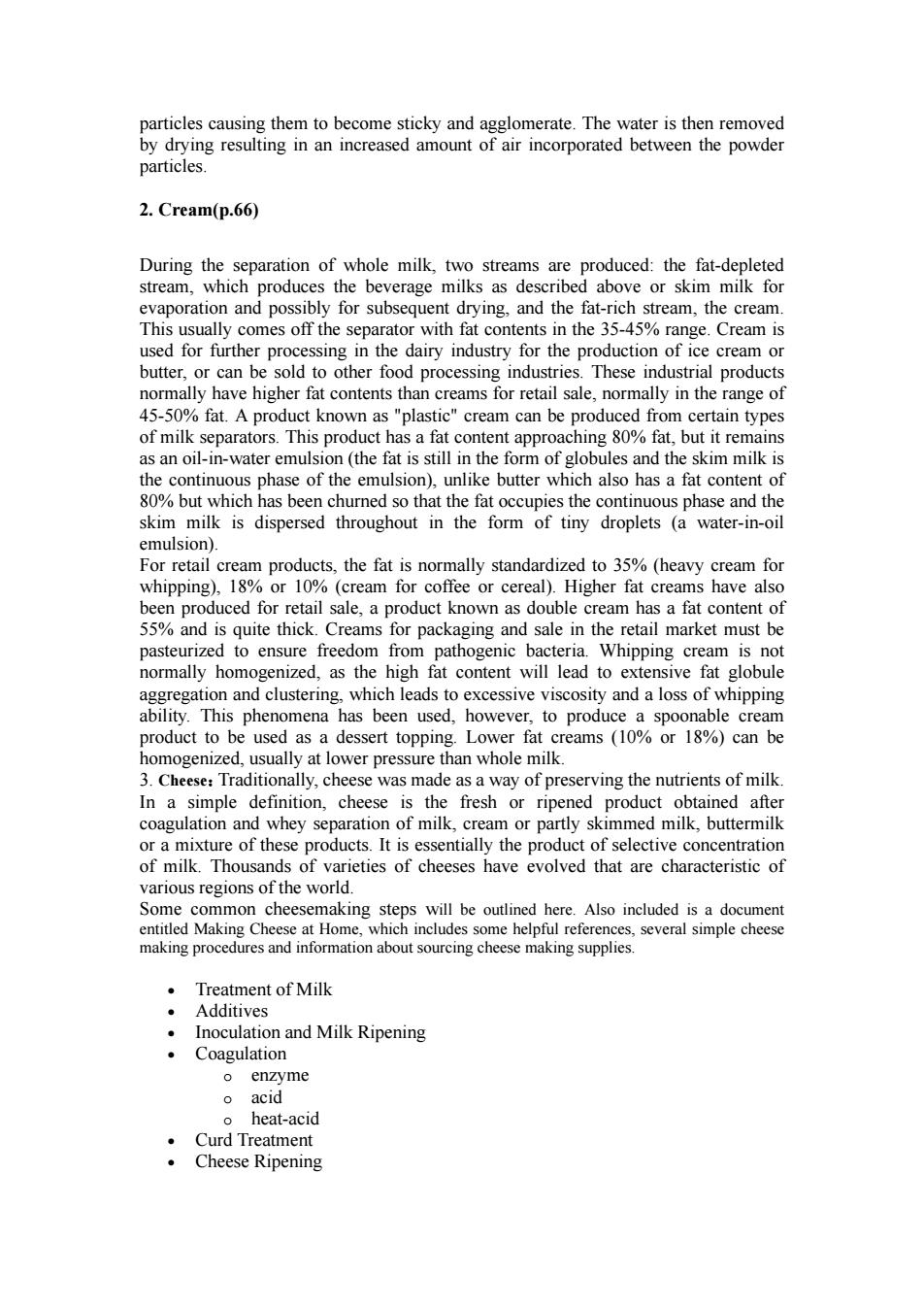正在加载图片...

particles causing them to become sticky and agglomerate.The water is then removed by drying resulting in an increased amount of air incorporated between the powder particles. 2.Cream(p.66) During the separation of whole milk,two streams are produced:the fat-depleted stream, whic the beverage milks as de ve or skim milk for n and pos Ior su rear cre d u the 、1 th y have high tail sale ally in the 15 500/fat A be oduced fr of milk se s This oduct has a fat co 800 fat hut it r as an mulsion (the fat in the form of and theskim mikis the continuous phase of the emulsion).unlike butter which also has a fat content of 80%but which has been churned so that the fat occupies the continuous phase and the skim milk is dispersed throughout in the form of tiny droplets (a water-in-oil emulsion). For retail cream products,the fat is normally standardized to 35%(heavy cream for bcPpehc%ocret6ceanmnccmtieorcereab Higher fat creams have alsc ale,a produc 1 as ole crean content o pac ens ea obul and This ha a loss oduct to d as a fat s(10% r180%)ca nized han whole milk 3 Che se Traditionally,chees was made as a way of preserving the nutrients of milk In a simple definition.cheese is the fresh or ripened roduct obtained after or a mixture of these products.It is essentially the product of selective concentration of milk.Thousands of varieties of cheeses have evolved that are characteristic of various regions of the world Some common cheesemaking steps will be outlined here.Also included is a docu Ma and inf ng chare hel Treatment of milk ·Additives Inoculation and Milk Ripening 。Coagulation o enzyme o acid heat-aci particles causing them to become sticky and agglomerate. The water is then removed by drying resulting in an increased amount of air incorporated between the powder particles. 2. Cream(p.66) During the separation of whole milk, two streams are produced: the fat-depleted stream, which produces the beverage milks as described above or skim milk for evaporation and possibly for subsequent drying, and the fat-rich stream, the cream. This usually comes off the separator with fat contents in the 35-45% range. Cream is used for further processing in the dairy industry for the production of ice cream or butter, or can be sold to other food processing industries. These industrial products normally have higher fat contents than creams for retail sale, normally in the range of 45-50% fat. A product known as "plastic" cream can be produced from certain types of milk separators. This product has a fat content approaching 80% fat, but it remains as an oil-in-water emulsion (the fat is still in the form of globules and the skim milk is the continuous phase of the emulsion), unlike butter which also has a fat content of 80% but which has been churned so that the fat occupies the continuous phase and the skim milk is dispersed throughout in the form of tiny droplets (a water-in-oil emulsion). For retail cream products, the fat is normally standardized to 35% (heavy cream for whipping), 18% or 10% (cream for coffee or cereal). Higher fat creams have also been produced for retail sale, a product known as double cream has a fat content of 55% and is quite thick. Creams for packaging and sale in the retail market must be pasteurized to ensure freedom from pathogenic bacteria. Whipping cream is not normally homogenized, as the high fat content will lead to extensive fat globule aggregation and clustering, which leads to excessive viscosity and a loss of whipping ability. This phenomena has been used, however, to produce a spoonable cream product to be used as a dessert topping. Lower fat creams (10% or 18%) can be homogenized, usually at lower pressure than whole milk. 3. Cheese:Traditionally, cheese was made as a way of preserving the nutrients of milk. In a simple definition, cheese is the fresh or ripened product obtained after coagulation and whey separation of milk, cream or partly skimmed milk, buttermilk or a mixture of these products. It is essentially the product of selective concentration of milk. Thousands of varieties of cheeses have evolved that are characteristic of various regions of the world. Some common cheesemaking steps will be outlined here. Also included is a document entitled Making Cheese at Home, which includes some helpful references, several simple cheese making procedures and information about sourcing cheese making supplies. • Treatment of Milk • Additives • Inoculation and Milk Ripening • Coagulation o enzyme o acid o heat-acid • Curd Treatment • Cheese Ripening